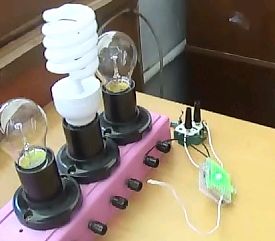Categories: Home automation, Sockets and switches
Number of views: 43218
Comments on the article: 3
NooLite lighting control units: what can toy boxes do?
 Getting acquainted with the NooLite line of modules from the Nootehnika company, one does not leave the feeling of admiration mixed with distrust. Do these toy, small devices, costing less than a common magnetic starter, have such an impressive array of capabilities? However, in NooLite system, which the manufacturer positions as specialized for lighting control, modern ideas are laid down, and it is executed at a high technical level.
Getting acquainted with the NooLite line of modules from the Nootehnika company, one does not leave the feeling of admiration mixed with distrust. Do these toy, small devices, costing less than a common magnetic starter, have such an impressive array of capabilities? However, in NooLite system, which the manufacturer positions as specialized for lighting control, modern ideas are laid down, and it is executed at a high technical level.
We will consider the capabilities of lighting control modules using the example of several representatives of a line of blocks whose nomenclature is constantly expanding. These are two control panels (transmitters) PU212-1 and PU313-1, power blocks (receivers) SN111-300 and SL111-300, and for those who like to manage everything from a computer, the adapter for the PC118 computer.
The design of the transmitters is identical and designed for stand-alone operation in any convenient place. Appearance is stylized as a standard switch, attached to the wall with a "Velcro" or two dowels of small diameter.
The front panel with membrane buttons has an LED indicator of the operating mode. The console has a 3V lithium disk battery with a life of about a year. The differences are in the purpose of the control buttons: model 212 is a remote control with control over two channels: in one, you can turn the load on and off with the brightness control of the lamps. The second channel is used to save and call the "script".
Under the "script" is meant any individual user configuration of one or more executive power units. This may be the level of glow of the lamp in the chandelier when watching TV or a group switching off the light in the apartment with the touch of a button when leaving for work.
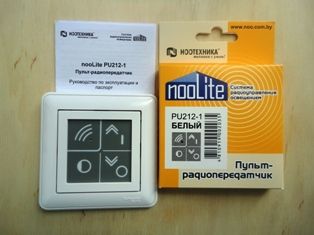
PU212-1 control panel
The console of model 313 is similar to 212 models, but has one more independent regulation channel, i.e. 2 load control channels and 1 script call channel. The PC118 remote adapter is designed to control power channels over 8 channels. Since it has a USB port and is powered by a computer, its transmitter is more powerful and its range is up to 70 meters. Included is a software package with which you can organize control of the entire system without getting up from your computer.
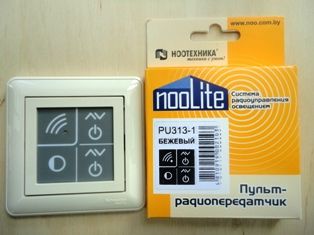
PU313-1 control panel
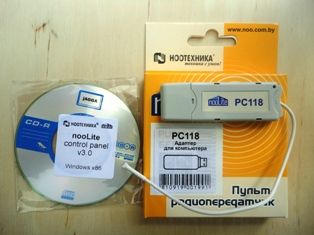
Remote controller-adapter for computer PC118
Now let's move on to the power receiver blocks. The symbol N in the designation SN111-300 means use for general-purpose incandescent lamps and halogen lamps with an electromagnetic step-down transformer. A hyphen indicates a maximum load power of 300 watts. The power unit has the ability to adjust the brightness of the lamps. For this type of blocks, the lower limit of the load power is 40 W, so low-power light sources will not be able to work with them.
Accordingly, the L symbol in the marking of another unit indicates its specialization - control of fluorescent lamps. There is no brightness adjustment for this type of module, but there is no limitation on the minimum load power.
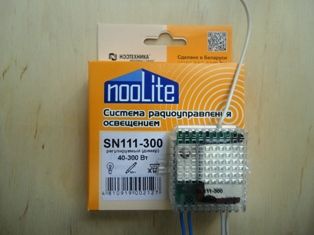
Power Block SN111-300
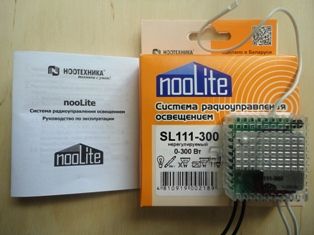
Power block SL111-300
Blocks are connected very simply: zero and the phase of the external network are fed to the input, and the load is output. Just two-wire inclusion of modules and prevents their direct installation instead of the switch. The phase can be connected to the module in any order, but, based on the rule, that it should go to the central contact of the lamp holders, trace the phase wire and connect to the desired location is desirable.
The Achilles heel of the power receiver blocks is the antenna. Its length is such that it is not possible to mount the antenna correctly in lamps or chandeliers.It is also impossible to turn around the case - the sensitivity of the receiver drops sharply. In addition, the metal parts of the luminaires additionally shield it from radio waves. To bring out and fasten to a ceiling - the design of the lamp and the room spoils.
It is possible that damage to the insulation of the antenna, which is under the potential of the network. This is due to the power features of the power unit circuit. Therefore, in each case, the placement of the antenna on the conscience of the consumer: it should be straight, without sharp bends.
There remains the question of the operation of the power key of the blocks. The absence of cooling elements indicates its pulsed mode of operation with sharp surges of the load current. If the interference from the radio channel is not particularly significant - the frequency is in the amateur range, and the transmitter power is small, then switching powerful loads inevitably causes electromagnetic interference in the network. No interference filter elements are visible on the block board, and it is difficult to place them there, given the miniature circuitry.
Another wish concerns the procedure for linking the remote control transmitters to power units. Although serious difficulties with the installation of systems are not visible, work skills and caution are necessary.
To bind the remotes to the power blocks, it is desirable to assemble a prototype circuit with a lamp. It is convenient to connect the blocks together and check the correctness of their functioning. After all, to press the function buttons on the power unit at a height is inconvenient and unsafe.
An example of a test inclusion of NooLite lighting control units in a breadboard diagram
And more about the use of control systems. If a city dweller light control problem in a cramped apartment seems far-fetched, then residents of rural areas may disagree with him. Managing the exterior lighting of the house, turning on the light in the outbuildings or the cellar is just a small list of tasks for such systems.
Of course, no matter how much you read about the merits or demerits of these products, the best way is to try them yourself and get your own opinion.
See also at i.electricianexp.com
:

